Эпизод 1. Одомашнивание
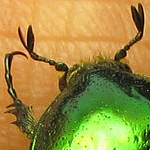 Март — волнующая пора для садовода. Душа истосковалась по открытому небу и безбрежной зелени, пению птиц и порханию бабочек... Когда же, когда уже сойдёт этот чёртов снег? Как там перезимовали розы? Какая будет в этом году весна? С роем подобных вопросов в голове и с радостью в сердце, настоящий цвето-и-овощевод уже с февраля оживлённо перебирает пакетики с семенами, замешивает в большом тазу вкусную земельку и сеет, пикирует, растыкивает по рассадным горшочкам, поливает, переживает «почему не взошло» и «неужели в этом году не будет астр?!», пересевает... И так до мая.
Март — волнующая пора для садовода. Душа истосковалась по открытому небу и безбрежной зелени, пению птиц и порханию бабочек... Когда же, когда уже сойдёт этот чёртов снег? Как там перезимовали розы? Какая будет в этом году весна? С роем подобных вопросов в голове и с радостью в сердце, настоящий цвето-и-овощевод уже с февраля оживлённо перебирает пакетики с семенами, замешивает в большом тазу вкусную земельку и сеет, пикирует, растыкивает по рассадным горшочкам, поливает, переживает «почему не взошло» и «неужели в этом году не будет астр?!», пересевает... И так до мая.
Где-то среди этих хлопот он и явился, прямо из земли. Готовя очередной таз почвы под рассаду, мама расщепляла руками слишком крупные комочки, и один из них неожиданно превратился в прекрасную бронзовку.
Надо сказать, летом на клумбах эти жуки — персоны нон-грата, т.к. сильно погрызают цветы. У меня к ним смешанные чувства, как и к одуванчикам: с одной стороны, они «вредные», а с другой — такие, заразы, красивые! А вот у мамы к тем и другим строго негативное отношение, ибо достали очень. Но в марте, когда мрачное питерское небо хмурится в окно, а сугробы подтаяли и выпятили наружу всё накопившееся за зиму людское свинство, обрадуешься даже врагу, если он зелёный, блестящий и жужжит. И бронзовка стала нашим новым домашним животным.
Episode 1. Domestication
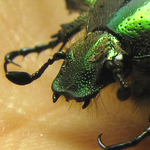 March is an exciting time for a gardener. The soul is longing for wide skies and boundless greenery, singing birds and flying butterflies... When the hell will the snow melt, at last? Are the roses ok? Will the spring weather be good or bad? With the head full of such questions and with the heart full of joy, the flower-and-vegetable-grower starts in February the new campaign of sorting seeds, making yummy soil and sowing, transplanting, putting into planting pots, watering, pondering “why these seeds did not sprout” and “oh my, are we going to live without asters this year?!”, sowing again... And that happens continuosly until May.
March is an exciting time for a gardener. The soul is longing for wide skies and boundless greenery, singing birds and flying butterflies... When the hell will the snow melt, at last? Are the roses ok? Will the spring weather be good or bad? With the head full of such questions and with the heart full of joy, the flower-and-vegetable-grower starts in February the new campaign of sorting seeds, making yummy soil and sowing, transplanting, putting into planting pots, watering, pondering “why these seeds did not sprout” and “oh my, are we going to live without asters this year?!”, sowing again... And that happens continuosly until May.
And among all this bustle he came. When mom was doing another basin of soil for seedlings, she was splitting too large pieces of soil in her hands, and one of these pieces suddenly turned into a splendid rose chafer.
To tell the truth, in summer these beauties are a disaster for our flower-beds, because they feed on flowers and eat a considerable lot of them. I have mixed feelings for them, just like for the dandelions: on the one hand, they are “pests”, but on the other hand, these rascals are so beautiful. Unlike me, mom has a strictly negative attitude both to rose chafers and dandelions, because she is tired of them. But in March, when cloudy north skies frown into the window, and the snow started to melt and show all the garbage collected from swinish citizens through the winter... In March you will be happy to see even an enemy, if it is green, shiny and buzzing. So, the rose chafer became our new pet.
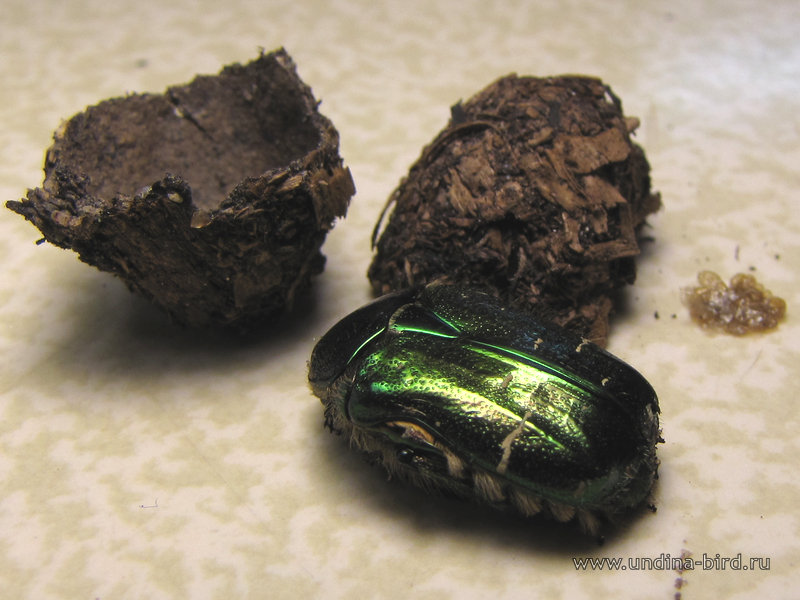
Бронзовка в позе эмбриона и её кокон
Бронзовочьи дети обитают в неживом, но питательном органическом субстрате (наш опыт показал, что куча конского навоза отменно подходит) и этим же субстратом и питаются. Потом они окукливаются и становятся похожи на комочек того субстрата, в котором выросли. Внутри кокона находится куколка (на фото видно её остаток —гладкую плёночку у правого края). А потом весной вылупляются новые жуки и летят украшать и поедать наши клумбы.
Rose chafer in embryo pose and it's cocoon
Chafer's children live in non-living but nutritious substances (according to our experience, a heap of horse manure is an excellent match) and feed on the same substance they live in. Then they pupate and get a look of hard piece of their native substance. Inside the cocoon is a pupa (you can see a film-like piece of it in the right part of the photo). And in spring the new-born beetles come out of the cocoons to decorate and destroy our flower-beds.
Эпизод 2. Тихо шифером шурша...
Прекраснокрылого засланца лета поселили в банку, на донышко насыпали земли, в которую он тут же радостно закопался. А вот с кормлением возникли вопросы. Летом он ест цветы, особенно любит лилии, пионы и сложноцветных. А где я ему лилии зимой возьму? От любезно предоставленного клубневой бегонией махрового цветка жук отказывался, от яблок и груш — тоже, а от ломтика апельсина (кормят же бабочек апельсинами в спецзаведениях — я видела) закапывался в землю с удвоенной скоростью.
Я не особо беспокоилась из-за такого вынужденного голодания, т.к. насекомые холоднокровны и могут преспокойно жить без еды неделями, а при прохладном содержании их обмен веществ и вовсе замедленный. Жук тоже не парился: пожужжит да зароется. Так что я накрыла банку крышечкой с крупными дырками, придавила куском проволоки (чтобы не сбросил) и не спеша размышляла, чем же его кормить.
Потом я уехала и 2 дня обитала в других местах. Возвращаюсь — мама эмоционально излагает о своих отношениях с жуком. «Твой жук меня чуть с ума не свёл! Он каким-то образом смылся из банки, залетел в мою комнату, забрался в кучу вещей, разложенных по полиэтиленовым пакетам, и там громко шуршал! Я думала, это либо мышь, либо у меня крыша поехала!» Я хмыкнула: «Совсем как в классике: тихо шифером шурша, крыша едет не спеша». Но мама у меня не робкого десятка, поэтому она смело отправилась на бой с непонятным шуршанием в углу, извлекла оттуда бронзовку и водворила на место.
Как он сбежал, было непонятно. По словам мамы, крышка оставалась на банке, а жук всё-таки оказался снаружи. «Регбус, краксворд» (с)...
Episode 2. Where is rustling?
We put the shiny-winged agent of summer into a jar, added some soil, and he digged into the soil and probably was happy. But there was a problem about feeding. In summer rose chafers eat lilies, peonies and Compositae. But the lilies are sleeping, and a big flower, courtesy of begonia tuberhybrida, pieces of apple and pears — everything was rejected. I also tried to offer the beetle a piece of orange (I saw that butterflies were fed by pieces of orange), but the beetle rushed away from it.
I wasn't too much bothered by prolonged lack of food, as insects are cold-blooded and thus many of them can live without food for weeks, especially in cool environment, which makes their metabolism slower. The beetle did not look much bothered, too: sometimes he buzzed a little and then went to sleep again. I put on a jar a cover with holes for aeration, made it heavy enough by putting a piece of wire (so that the beetle would not throw it down) and continued to look for new kinds of food.
Then I went away for 2 days and lived elsewhere. When I returned, mom told me about her exciting relationships with the beetle while I was away. “Your beetle almost drove me mad! He managed to escape from the jar, flew into my room, dug into a heap of things in plastic bags and rustled loudly! I thought it was either a mouse or I'm getting crazy”. Well, my mom is brave enough to find out what is rustling in the corner... So, she discovered the beetle rustling among the bags and put it back into the jar.
How did he go out of the jar? That was a riddle. Mom told that the cover was on it's place, but somehow the beetle appeared to be outside. Hm...
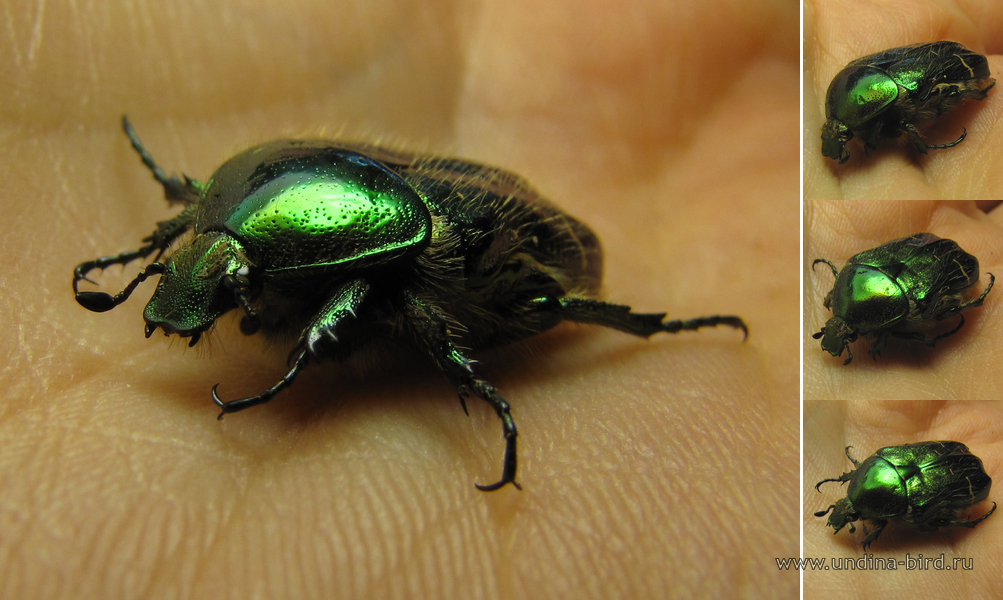
Согрей его в своих руках
Насколько я могу судить, бронзовки весьма теплолюбивы. Большую часть дня они проводят в «анабиозе», закопавшись либо целиком в землю, либо мордой в пищу. Но возьмите бронзовку в руки — и в любое время дня и ночи вы увидите, как согретый жук трансформируется из позы эмбриона в позу исследователя, озирает мир своими большими чёрными глазами, некоторое время вертит головой, сканируя местность (в это время удобно его фоткать)... А затем бодро устремляется на поиски, во что закопаться. Или улетает, если клювом прощёлкаете.
Warm him in your hands
As far as I understood, the chafers are heat-lovers. They spend most part of the day in “anabiosis”. To have a nice sleep, the rose chafer either digs itself into the soil or digs it's face into the food. But take a rose chafer into your hands — at night or in day — and you will see the warming beetle transforming from “embryo pose” into an explorer, looking at the world with big black eyes, turning his head to scan the surroundings (that's the best moment for taking photos)... And then suddenly he rushes somewhere to find some soil or food to dig in. Or flies away, if you are not alert enough.>
Эпизод 3. Ой!
Так мы и жили. Каждый день жук жужжал минут по 5, а я от этого начинала беспокойно метаться по квартире и думать, чем бы его покормить. Потом жук отказывался от предложенной пищи и закапывался в землю, а я возвращалась к своей работе.
Проблема питания решилась вдруг. Когда я уже морально была готова идти в цветочный магазин и покупать этому засланцу букет хризантем, мой взгляд упал на банан. Банан, банннааааан... В зоопарке насекомых почти во всех инсектариях лежали кусочки банана... Эврика! Жук вздохнул с облегчением («Наконец-то убрали отсюда этот вонючий апельсин!») и воткнулся в пищу, мы тоже вздохнули с облегчением («Ура, в цветочный переться не надо!») и разбрелись по своим делам.
Через полчаса я заглянула в банку, чтобы проверить, как идут дела у питомца. «ОЙ!» — громко сказала я. Тут же прибежала мама: «Где ой? Что ой?» Я показала на банку. «ОЙ!» — громко сказала мама. Я напустила невозмутимый вид: «Мам, ответь мне, пожалуйста, сколько ты видишь жуков?»
Жуков было двое.
Разгадку вычислили быстро. Жук, который шуршал маминым шифером во втором эпизоде, не убегал из банки. Это просто был другой жук, который вылупился самостоятельно, вылез из мешка с землёй и отправился на поиски счастья. А из-за того, что большую часть времени бронзовки проводили в земле, мы и не смогли их сосчитать, пока не появилась привлекательная пища :))
Друг к другу бронзовки совершенно безразличны. У них вообще маленькие запросы по жизни: поесть, пожужжать 5 минут — и спать. Кроме того, в их характере есть что-то от Карслона. Каждый раз, когда приходит Андрей и я собираюсь ему показать красивых жучков в банке, они очень быстро закапываются в землю, даже если до этого спали пол-дня, уткнувшись мордами в банан. Так что после всех моих рассказов о прекрасных жуках Андрей снова и снова видит лишь банку, в которую насыпано немного земли, положен кусочек банана... и никого нет. :)
Интересно, смогут ли они дожить до того времени, когда вылупятся их сородичи в природе?
Episode 3. Oh!
And so we lived piecefully. The beetle had his daily 5 minutes of buzz, and in these minutes I bustled around seeking for new possible ideas of how to feed him. Then he stopped buzzing and dug into the soil, and I stopped bustling and dug into my work.
All of a sudden, the feeding problem was solved. When I was already thinking that I have to go into a flower shop and buy a bouqet of chrysantemums for my beloved pest, I mentioned a banana on the table. Banana, bannnaaaaana... In the insect zoo which I visited in January, there was a piece of a banana almost in every insectary... Eureka! The beetle breathed with relief (“At last they took away this stinky orange!”) and tucked into the food, we breathed with relief (“No need to rush into the flower shop!”) and everybody returned to normal life.
After a half an hour I looked into the jar to see, how is my happy fed pet doing. “OH!” I said in excitement. Mom ran to me immediately. “Where is oh? What is oh?” I pointed to the jar. “OH!” said mom in excitement. I tried to look calm: “Mom? Tell me please, how many beetles do you see in the jar?”
There were 2 rose chafers.
All the riddles were solved in a minute. The beetle who maddeningly rustled in the episode 2, did not escape from the jar. It was completely another beetle, he went out of the cocoon himself, escaped from the bag with the soil and set out to look for happy life. But in the jar the beetles spend most of their time in the soil, and that prevented us from counting them properly until we delivered a piece of attractive food. :))
The rose chaffers apeered to be completely indiffirent to each other. They have very modest requirement for life: eating, 5-minute buzzing — and sleeping again. There is also one funny trait in their character. Every time when Andrei comes home and I'm going to show him “the beautiful bugs I've got”, they swiftly dig into the soil, even if before that they spent half of the day sleeping on the surface with their faces plunged into banana. Thus, after all my stories about nice and funny beetles, again and again Andrei sees only a jar with some soil, a piece of banana and... nobody inside. :)
I wonder, will they live long enough until their brethren in nature come out of their cocoons?
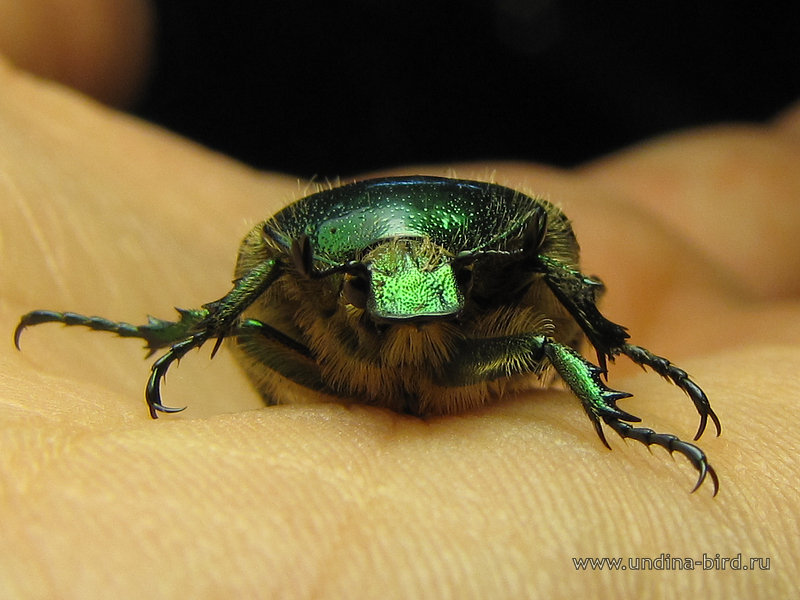
Бронзовка бородат(а)
Бронзовки умудряются сочетать гламурный блеск с практичной волосатостью (или няшной пушистостью — это как посмотреть). Даже сияющая спинка, и то вся в волосках. А уж на подбородке и брюшке — можно сказать, мех. Почему я считаю, что это практично? Я не нашла информации на этот счёт, но по моим наблюдениям, эти волоски — возможная причина того, что выкопанная из земли бронзовка за минуту становится совершенно чистой. Мелкие комочки земли осыпаются с неё сами собой. Ни разу не видела грязную бронзовку. А вот гладкие
жужелицы, которых я фотографировала летом, подолгу бегают заляпанными по уши.
The rose chafer has a bierd
Rather paradoxically, rose chafers are both glamourously glittering and pragmatically hairy (or charmingly fluffy — depens on your attitude). Even the shining back is covered with sparse hair. And on the chin and belly it's literally fur. Why do I think that pragmatic? I haven't found info about that, but my observation is that these hair may allow the beetle, when going out from the soil, to become ideally clean in a minute. Small pieces of mud peel off “themselves”. I've never seen a dirty rose chafer. You can compare that with a photo of a smooth
ground beetle — it remained muddy for a considerable time.
Приквел
Если кто сейчас начнёт бояться или наоборот надеяться, что прекрасные существа появятся и у них из магазинной земли, то это напрасно. Вот как они у нам попали: осенью, перед отъездом с дачи в город, мама набрала с собой мешочек конского навоза на память для плодородной смеси под рассаду. А в навозе как раз и жили большие белёсые личинки бронзовок в огромных количествах. Только мы тогда ещё не знали, чьи это дети. А в магазине продают торфогрунт, там такой живности нет.
Prequel
If any of you is going to bother or hope that these shiny creatures will come out from the pot soil you buy in the shop — that's hardly possible. Here is how the rose chafers got into our home: in autumn, when we were preparing to move from the dacha into the city, mom took a bag of horse manure as a keepsake to make fertile soil for planting seedlings in spring. And this manure was home for a big number of rose chafers' larvae. Before now, we didn't know whose children are they. And in the shop they sell peat soil, and there is no such biodiversity.
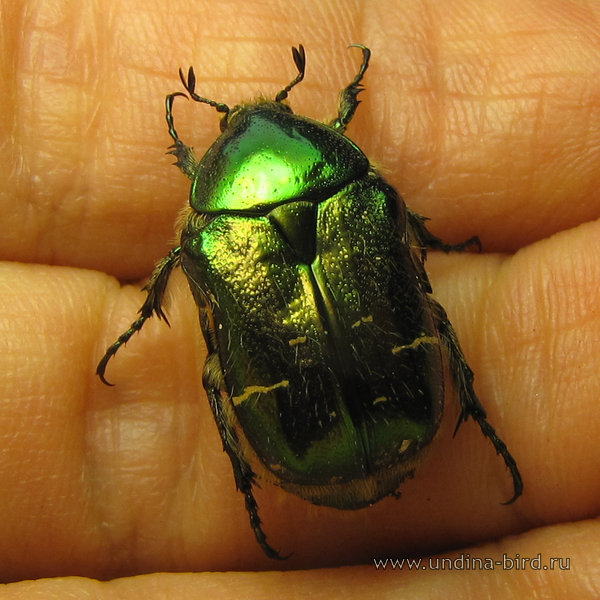
Не верьте своим глазам, он не зелёный ;)
Зарубежная википедия говорит, что цвет бронзовок (как и многих других насекомых, а также птиц) — результат оптической иллюзии. В экзоскелете этого жука нет зелёного пигмента. То, что вы видите — результат круговой поляризации света.
бронзовка обыкновенная, или золотистая Cetonia aurata — род бронзовка Cetonia — сем. Пластинчатоусые Scarabaeidae — отряд Жесткокрылые, или Жуки Coleoptera — класс Насекомые Insecta — тип Членистоногие Arthropoda — Животные Animalia
Бронзовка на лилии
Rose chafer on a lily
Бронзовка на нивянике
Rose chafer on a leukanthemum